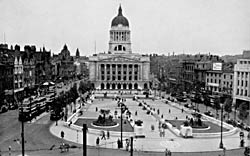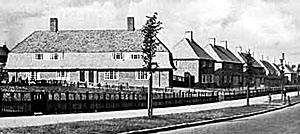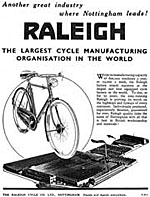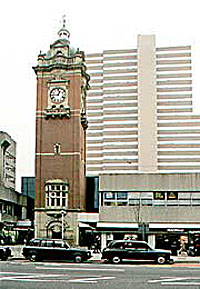
Overview: the 20th century

The Market Square in 1938, now dominated by The Council House (1929).
During the twentieth century Nottingham developed in a manner quite distinct from anything that had gone before. After the First World War population grew more slowly than at any time since the seventeenth century: over the eighty year period 1911-91 numbers rose only marginally, and this increase actually hides a substantial fall since 1961 as people have moved from the centre to the suburbs. The age structure also altered. By the 1990s the city had far fewer fifteen year olds and many more elderly people than in earlier generations. Household size also altered dramatically: in 1911 the average Nottingham household consisted of 4.33 people, but in 1991 the figure was just 2.37.
As household size fell, the number of households increased by 82 per cent 1911-91. Over the same period a greater number of people began to live alone, and as a result there was an 85 per cent increase in occupied houses within the city boundaries. The average household came to enjoy greater space (both inside and outside of the house), and the residential area of the city more or less quadrupled over the period 1916-94 in order to make this space available. In addition, many people began to live at a greater distance from the city centre because transport changes and prosperity have together made travel easier.
Nottingham's buildings suffered little damage through enemy action in the First World War, although many local people were killed in action. As was the case in many cities, the survivors returned to homes which were by no means fit for heroes. Through unavoidable neglect the housing stock deteriorated during the war, and clearance schemes agreed prior to 1914 for the inner-city areas were abandoned. By 1919 nearly 9,000 houses were considered to be unhealthy.
In 1920 the corporation applied for a further boundary extension, partly to ease population congestion in the city centre, but this was turned down by central government. This refusal was a massive blow to civic pride. The ‘Queen of the Midlands' image was severely dented, but the response was dynamic as the corporation launched a massive modernization programme for the disposal of domestic sewage, alongside a major house building programme.

Council houses on Western Boulevard, Whitemoor Estate.
Between the two World Wars the 17,461 houses built by the corporation represented 65.5 per cent of the total addition to stock. Twenty municipal estates were built on ‘green-field' sites and many other smaller schemes on undeveloped tracts of land within the built up area. To accommodate further development, a boundary extension was obtained in 1932. Land to the north and west of the city centre was added to the town, and this was where new council houses were built in the 1930s. Slum clearance was undertaken in the 1920s in the notorious Marsh district, and the old back to backs were replaced by council houses.
With the dispersal of population from the city centre, more people were travelling greater distances to work. An outer ring road was built between 1920 and 1932, Trent Bridge was doubled in width by 1926, and University Boulevard was built. Streets in the city centre were widened to ease traffic congestion, including Parliament Street and Huntingdon Street in 1932.
Public transport provision was increased. Electric trams were introduced in 1901 but phased out by 1936 to be replaced by trolley and motor buses. Many of the routes ran into or through the Old Market Square, which was transformed 1927-9 with the building of Cecil Howitt's imposing neo-Baroque Council House, and the re-arrangement of the old market place.
The inter-war housing schemes gave many families a much improved standard of living. The death rate declined steadily in the later decades of the nineteenth century as life expectancy rose, and this trend was sustained into the twentieth century. From around 1900 it was greatly assisted by a decline in child mortality. Deaths from infectious diseases and from traditional childhood diseases have fallen rapidly.
In part these changes resulted from improved diet. In the Edwardian era getting enough to eat was still a problem for many families, and housewives had to do economic miracles with insufficient resources. After 1918 families were still not well off. For financial reasons children had to contribute to the family income for most of first half of twentieth century, and some had many responsibilities, little time for play, and few toys. Boys chopped wood, fetched water, ran errands, looked after barrows at the cattle market, collected jam jars and rags to sell, and made deliveries from shops. Girls helped with the housework and looked after younger children.
Few families had money to burn, but in general the inter-war suburban housewife was better off and had more household gadgets than her mother and grandmother. While many regretted the loss of community spirit when they moved from slum areas to new housing estates, others revelled in the luxury of an iron bath, an electric light, a water closet, and a garden back and front.
Despite their limited resources, families increasingly found time for leisure, following professional sporting activities (football and cricket), and paying regular visits to the cinema. Nottingham had seven picture houses in 1913, and more than thirty by the 1930s when they had replaced variety halls as the most popular form of univeral entertainment. Alan Sillitoe, the Nottingham author, remembered the pictures as ‘a solace and a consolation', and for many local children a visit to the cinema was the highlight of the week.
The churches offered a voluntary programme of social activities including Sunday School outings and cheap camping holidays, while the major companies such as Boots, Players and Raleigh, organised leisure and educational pursuits on behalf of their employees. Political groups, including the Co-operative Society and the Communist party, sought to combine ideology with play.
The corporation provided parks, allotments and swimming baths, while many children were introduced to sporting and other leisure activities while at school. Traditional events survived, including Goose Fair, successfully re-established after 1918 against the wishes of the corporation and transferred to the Forest in 1928 when the Processional Way was formed in the Old Market Square. The opening in 1925 of the Palais de Dance provided the city with one of its most popular meeting and recreational venues.
Education provision had to reflect the wider changes taking place in the city, and from 1902 the Education Committee found itself hard pressed to provide enough buildings. The city had insufficient secondary places, which the Committee tried after 1918 to fill by providing central schools to serve the whole community. This initiative was overtaken when in 1924 the city's first Director of Education, Henry Whipple, began a further reorganization of the local school network by introducing hierarchies of schools.
For this purpose Whipple divided the town into sixteen notional districts, many of which were on the new council estates where ‘families' of schools were built, ideally with two non-selective senior schools, one for boys and one for girls, together with infant and junior schools. Secondary schools were to be the focus of community development, and to this end the William Crane schools at Aspley were the model. The school buildings were designed to maximise light and air.
Nottingham was and still is, a textile city, despite considerable changes in its economy in the course of the twentieth century. The lace industry went into rapid decline after the First World War as a result of changes in fashion. By contrast, hosiery enjoyed something of a renaissance as women's hemlines rose and the demand for stockings and underwear increased. Perhaps the most striking textile success of the first half of the twentieth century was in ready-made clothing, as many companies abandoned their own label to produce for the variety chain stores, initially Marks & Spencers.
In some ways textiles, because they were made by many small firms, have been less visible in the twentieth century city than the three giants which came into being at the end of the nineteenth century: Boots in pharmaceuticals, Raleigh in cycle manufacture, and Players in cigarette manufacture.
Jesse Boot began his retail business in Nottingham in the nineteenth century, and developed many of his manufacturing interests in the Station Street/Island Street area. During the 1920s Boots needed more space, and gradually moved to a large landfill site at Beeston.
A similar move, although later and for different reasons, was made by Players, whose major factories and warehouses of the late nineteenth century were built on undeveloped sites in Radford. Players became a major employer in the twentieth century city.

Advert for Raleigh bicycles, c.1939.
Similarly important was the rise of Frank Bowden's Raleigh as a consequence of the cycling craze of the 1880s and 1890s. After modest beginnings, a purpose built factory was built in the mid-1890s on five acres in Faraday Road, Lenton, and by 1912 the company was producing 50,000 cycles a year. Immediately after the War this had risen to about 100,000, and Raleigh had the largest cycle works in the world. Various factory extensions followed. The company enjoyed considerable prosperity in the inter-war years and production climbed to 500,000 cycles a year by 1938.
The city was again disrupted by the Second World War, although it did not experience the same level of damage as Coventry and other major cities.
The second half of the twentieth century saw Nottingham continue to evolve. Council house building, continued in the Bilborough and Bulwell areas and, following a further boundary extension in 1951 the Clifton estate - the size of a small town - was built in the years 1951-73. The Bestwood Park (1958-68) and Top Valley (1973-6) estates followed, and by 1981 approximately half of the city's households lived in council property. After that, government policies led to a reversal of this position with council houses sold off into private hands. Partly as a result demand outstripped supply and in 1996 there were 20,000 people on the city's council house waiting list.
Slum clearance was resumed in the 1960s and 1970s. In the St Ann's and Meadows area 25,000 nineteenth-century houses were swept away, while other schemes involved housing to the north of the city centre, particularly in Hyson Green and Basford.
The post-1918 housing estates, and the redevelopment of St Ann's and the other areas with low density housing, meant a continuing drift of population away from the centre, but it was accompanied by the rise of the private motor car. Over the last forty years of the century the use of buses in the city halved while total road traffic increased six-fold. By 1991 half of Nottingham's households had at least one car. To try to accommodate these changing habits, roads were widened and improved, new bridges were built over the River Trent (notably Clifton, opened in 1958 and widened in the 1970s), and an outer loop road was constructed.

The ornate clock tower from the long-since demolished Victoria Station (1900) contrasts dramatically with the monolithic and characterless Victoria flats (1973).
Within the city centre the problems of congestion proved almost insurmountable. An inner ring road scheme was abandoned in the 1960s following protests in the wake of the building of Maid Marian Way. The corporation tried to accommodate road traffic by providing car parking and developing park and ride schemes. While fewer people now live in the city centre than in the past, many more want to gain access to its major shopping malls, the Broad Marsh and Victoria Centres, opened in the 1970s.
These bring much needed business to the city but they are also symbolic of change over the past century: both sit astride what were in the 1890s major slum housing areas, and the Victoria Centre now in turn occupies the area originally redeveloped for the Great Central railway.
The dispersal of population has brought other changes, less well foreseen. At one level these have been advantageous. The various housing programmes, coupled with improvements in maternity and child welfare provision, helped to improve public health. Also important has been the post 1950 Trent flood protection schemes, which brought to an end the periodic inundation of up to 7,000 houses and factories in the Meadows and elsewhere with polluted water and sewage. Better hospital provision has also helped, initially through the opening of the City, and particularly since the opening in 1970 of the University Hospital.
Integration of incomers has not always been easy. Migrants have often
preferred to establish their own community-based leisure organizations,
in the case of the Polish and Ukrainian communities partly for nationalist
reasons, and for New Commonwealth migrants as a result of racial discrimination.
Outbreaks of hostility towards black migrants led to ‘race riots'
in 1958 and the 1980s, but immigrant ethnic groups and their British born
children have made a considerable contribution to city life. Nottingham
can boast the country's first black JP and sheriff. Viv Anderson, in 1976-7
the first black player to play for Nottingham Forest, went on to become
the first black player to represent
Boots has remained a major employer in the city, and still has the largest payroll, but the other major twentieth century industries have been the victims of changing social attitudes, habits and fashions. Players flourished until the 1960s, but the anti-smoking momentum whipped up by fears about links with ill health seriously affected the company. Although the Horizon factory at Lenton opened in 1971 amid optimistic hopes for the future, the Radford works have since been abandoned. Raleigh prospered in the post-war years, as output passed 1 million cycles in 1951, but as consumer preference shifted towards the motor cycle and car the firm suffered a decline in sales. It vacated its remaining Nottingham premises in 2001 and now survives only as an assembly unit in Eastwood.
A similar trend has occurred in textiles. After 1945 the hosiery industry continued to be relatively prosperous with employment levels in 1984 only slightly below those of 1924. This was largely because the dictates of fashion worked in favour of knitted as distinct from woven fabrics. On the other hand there were numerous company mergers, especially in the 1960s, as the industry came increasingly to depend on supplying the variety chain stores, and as it faced up to the twin pressures of competition from the Pacific rim and the rapid diversification and sophistication in fashions and consumer taste in the European market. Perhaps the most interesting result of the changes in taste has been the regeneration of the lace market for fashion clothing. The most outstanding success story is Paul Smith, the menswear designer, who opened his first boutique in Byard Lane in 1970, and today has a flagship headquarters on Low Pavement.
Other changes in employment opportunities have come about as a result of the growth of service industries, notably banking and insurance, and food and drink. The two Universities and the Queen's Medical Centre are among the leading employers in the city. Another important source of employment is government service, particularly since the location in Nottingham of the new Inland Revenue Offices.
In many respects the city has had a buoyant post-war image. The Festival of Britain in 1951 offered an opportunity for self-congratulation over the successful housing campaign, and the corporation sought with some success to promote the image of Nottingham as a cultural centre. Although a proposed civic arts centre was not constructed, the controlling Labour group promoted what became the first provincial theatre to be built since the War. The Playhouse building opened in 1963 and enjoyed a period a great popularity under the innovative directorship of John Neville. It was followed in the 1980s by the Royal Centre, which combined the refurbished Theatre Royal and the magnificent new Concert Hall.
In the 1960s and 1970s leisure centres were built in an attempt to provide sporting and recreational facilities for the whole community. Many were located alongside schools, which effectively restricted access and which led to a class bias in usage.
The city has also enjoyed the benefits of a positive image promoted by its sporting interests. Nottingham Forest, after many decades as a club of modest achievements, won the European Cup in 1979 and 1980 under the managership of Brian Clough, and enjoyed great success for many years thereafter, although in the early years of the twentieth first century the club fell on harder times. The county cricket side, led by two talented overseas players, Clive Rice and Richard Hadlee, and inspired by the Retford-born Derek Randall, won the county championship in 1981 and 1987, and all the cups during the 1980s and early 1990s.
In watersports the city gained a national focus with the opening of the Holme Pierrepont centre. National, international and World Cup events have all been held on its 2,000 metre rowing course, and a canoe slalom and water ski lagoon was added in 1985. The Olympic and World successes of the skaters Jane Torville and Christopher Dean brought new interest in ice skating, and the city's Ice Stadium, built in 1939, was replaced by the National Ice Centre, which is also home to one of the country's top ice hockey teams, the Nottingham Panthers.
These interests have brought other changes in their wake. The cinema enjoyed its heyday between the 1930s and 1950s, and since the 1970s has responded to changes in public demand, hence the multi-screen complexes including the out of town Showcase.
The changing structure of city life has also placed considerable demands on the education service. In 1957 the bi-lateral system was introduced into secondary schools to try to compensate for a shortfall in grammar school places. The first experiment in Comprehensive education was tried at Clifton in 1958. It spread to the whole city following local government reorganization in 1974.
In higher education the University of Nottingham moved from its city centre site to the Highfields campus in the 1920s, as a result of the generosity of Jesse Boot. It received its own charter in 1948 and subsequently greatly expanded the campus, adding a medical school in 1970 which combined with an integrated hospital of 1,400 beds. The Queen's Medical Centre was named as such in 1977 when Her Majesty visited the hospital. Nottingham University has taken over sites vacated by the Raleigh cycle company and the Carlton TV studios.
Nottingham Trent University, created as such in 1992, was an amalgam of the School of Art, Clifton Teacher Training College (founded 1960) and the Nottingham and District Technical College founded in 1945. It became Trent Polytechnic in 1974, and it now occupies buildings in the centre of Nottingham and at Clifton. Both universities owe their origin to initiatives taken by the corporation.